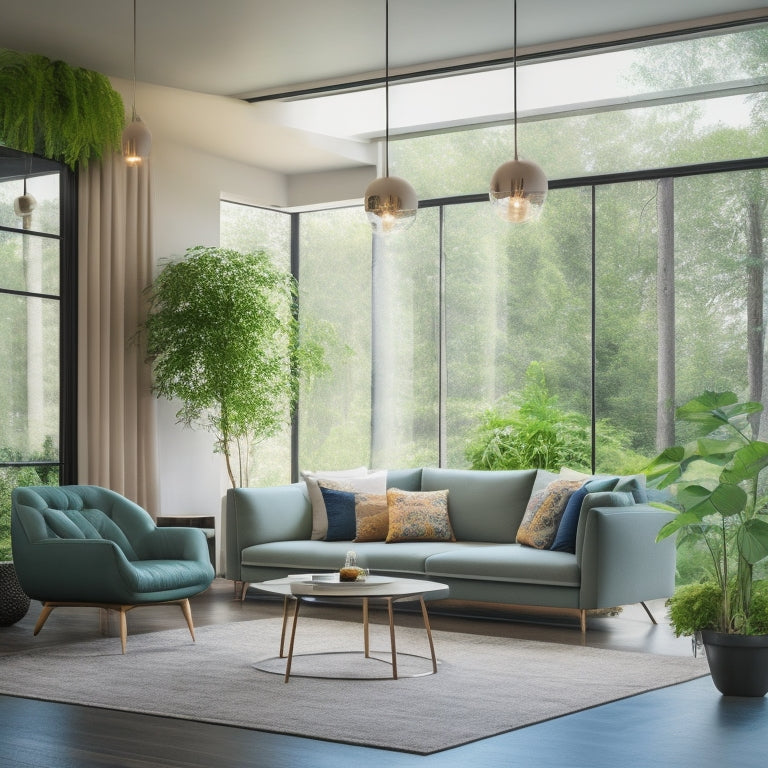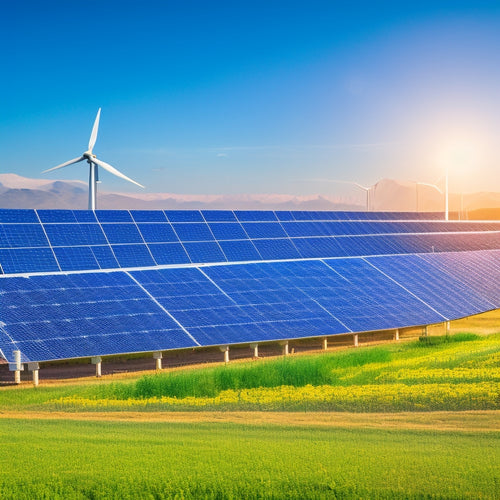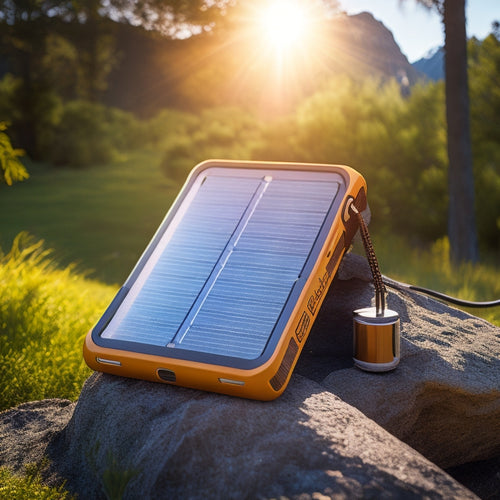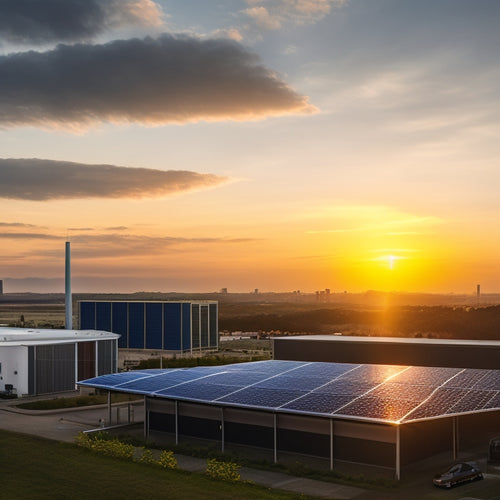
7 Best Eco-Friendly Home Lighting Systems
Share
You're looking to upgrade your home lighting to reduce your environmental footprint and energy bills. Effective eco-friendly solutions include utilizing natural daylight through strategic window placement and solar integration, solar-powered ceiling fixtures that convert sunlight into electricity, and energy-efficient LED lighting options that consume considerably less energy. Smart home automation systems with voice control and energy efficiency features can also reduce energy consumption. Additionally, renewable energy lighting options like solar gardens and wind-powered lights, along with sustainable design ideas and low-carbon footprint solutions, can further minimize your impact. Investigate these options to uncover the perfect blend of sustainability and functionality for your home.
Overview
- Harnessing natural daylight through strategic window placement and mirror usage reduces energy consumption and enhances spatial experience.
- Solar-powered ceiling fixtures convert sunlight into electricity, eliminating energy bills and minimizing environmental footprint.
- Energy-efficient LED lighting options consume significantly less energy than traditional bulbs, reducing waste and replacement costs.
- Smart home automation systems integrate with eco-friendly solutions, optimizing energy storage and consumption for a sustainable home.
- Sustainable design ideas, such as biophilic design elements and ambient lighting, create inviting atmospheres while reducing artificial lighting needs.
Harnessing Natural Daylight Effectively
One of the most effective ways to reduce your reliance on artificial lighting is to employ natural daylight effectively. You can do this by implementing daylight optimization strategies in your home.
Start by analyzing your window placement to guarantee it allows for maximum natural light penetration. Consider installing larger windows or skylights to bring in more daylight. Additionally, use mirrors and reflective surfaces to bounce natural light deeper into your home.
By incorporating solar integration into your room dividers, you can tap into natural light and create a brighter, more welcoming atmosphere. This approach not only reduces energy consumption but also enhances the spatial experience and promotes energy efficiency.
Solar Powered Ceiling Fixtures
When you install solar powered ceiling fixtures, you're leveraging energy harvesting technology to convert sunlight into electricity, powering your lighting system.
This innovative solution enables you to reduce your reliance on traditional energy sources, ultimately resulting in zero energy bills.
By utilizing the sun's energy, you'll not only minimize your environmental footprint but also enjoy significant long-term savings.
With Top-Rated DIY Solar Kits, you can choose from a range of options that cater to your energy needs, and Best Off-Grid Solar Systems that provide reliable power for remote living.
Energy Harvesting Technology
Several innovative companies are pioneering energy harvesting technology, which enables your ceiling fixtures to capture the sun's energy during the day and convert it into usable electricity. This technology allows you to utilize kinetic energy and store it for later use, reducing your reliance on traditional power sources. With energy harvesting, you can enjoy the freedom of sustainable living while minimizing your carbon footprint.
| Energy Harvesting Benefits | How it Works | Advantages |
|---|---|---|
| Reduces energy bills | Solar panels capture sunlight | Increases energy independence |
| Lowers carbon emissions | Energy is stored in batteries | Provides backup power during outages |
| Enhances energy security | Inverters convert energy for use | Offers a sustainable alternative |
Zero Energy Bills
Take your lighting to the next level with solar-powered ceiling fixtures that can slash your energy bills to zero.
You'll gain energy independence with off-grid solutions that utilize solar energy and store it in battery storage systems, ensuring a reliable energy source especially in remote areas with limited traditional infrastructure.
This green technology allows you to conserve energy while reducing your carbon footprint. Conduct an energy audit to identify areas for improvement, and consider installing smart meters to monitor your energy usage.
By incorporating sustainable materials into your lighting design, you'll be taking a significant step towards a carbon-neutral home.
With solar-powered ceiling fixtures, you'll enjoy the freedom of zero energy bills and a clear conscience, knowing you're doing your part for the environment.
Energy Efficient LED Lighting
You're probably aware that traditional incandescent bulbs are being phased out due to their inefficiency and environmental impact. Energy-efficient LED lighting is the way to go, offering numerous benefits for you and the planet. LED bulb innovations have led to eco-friendly designs that consume considerably less energy. With energy saving techniques, you can reduce your carbon footprint and lower your electricity bills.
| Feature | Benefits | Options |
|---|---|---|
| Light Color Temperature | Improves mood and focus | Warm White (2700K), Cool White (5000K) |
| Dimmable Options | Adjusts brightness to your needs | 0-100% dimming, scene settings |
| Smart Sensors | Automates lighting for convenience | Motion detection, daylight harvesting |
| Longevity Benefits | Reduces waste and replacement costs | Up to 25,000 hours lifespan |
LED lighting also offers cost savings, health benefits, and recycling programs. By switching to energy-efficient LED lighting, you'll enjoy a guilt-free, cost-effective, and healthy lighting experience.
Smart Home Automation Systems
You'll find that smart home automation systems offer a range of benefits, including voice control options that let you adjust your lighting with simple voice commands.
These systems also come equipped with energy efficiency features that help you reduce your energy consumption and lower your utility bills.
By integrating your lighting system with other smart devices, you can create a seamless and efficient home automation experience that's customized to your needs.
Furthermore, smart home automation systems can be powered by eco-friendly power systems, such as solar solutions, which provide a sustainable and renewable source of energy.
Additionally, these systems can be designed to optimize energy storage solutions, such as lithium-ion batteries, to guarantee a reliable and efficient power supply.
Voice Control Option
Your smart home automation system's voice control option is the ultimate breakthrough, allowing you to command your lights to turn on, off, or adjust their brightness with mere vocal cues.
This feature brings hands-free convenience to your daily life, freeing you from the hassle of manual switches or remotes. With voice activation benefits, you can multitask effortlessly, focusing on other tasks while your lights respond to your every command.
Imagine walking into a room and simply saying "turn on the lights" or "dim the lights to 50%". The voice control option gives you the power to control your lighting system with ease, providing you with the freedom to live life on your own terms.
Energy Efficiency Features
Incorporating energy-efficient features into your smart home automation system is a crucial step towards reducing your carbon footprint and saving on energy costs.
You'll want to evaluate conducting energy audits to identify areas of improvement and prioritize energy-hungry devices.
Lighting retrofits can be a great starting point, as they can greatly reduce energy consumption. Look for systems that use LED bulbs, which use up to 90% less energy than traditional incandescent bulbs.
Additionally, contemplate installing occupancy sensors and timers to guarantee lights are only on when needed.
Seamless Integration Possibilities
The smart home automation system's seamless integration possibilities offer a wide range of benefits, allowing you to control and monitor your eco-friendly home lighting system from a single interface.
You can customize your lighting experience to fit your design aesthetics and user experience preferences. Installation flexibility means you can integrate your lighting system with existing smart home devices, ensuring compatibility options are endless.
Ambient settings can be adjusted to your mood and environment, while maintenance requirements are minimized with automated software updates.
Budget considerations are also addressed, as you can schedule lighting scenes to optimize energy efficiency.
With lighting versatility at its core, you'll enjoy unparalleled freedom to create the perfect ambiance in your eco-friendly home.
Renewable Energy Lighting Options
As you investigate the world of eco-friendly home lighting, you'll uncover a plethora of renewable energy lighting options that not only reduce your carbon footprint but also provide a sustainable alternative to traditional lighting methods. These innovative solutions capture energy from natural sources, ensuring a cleaner and healthier environment.
| Renewable Energy Option | Description |
|---|---|
| Solar Garden | Captures energy from the sun to power lights |
| Wind Powered Lights | Exploits wind energy to generate electricity |
| Bioluminescent Fixtures | Uses living organisms to produce light |
Incorporating these renewable energy lighting options into your home can be achieved through various means, including battery storage, off-grid systems, and hybrid lighting. Additionally, urban greening and eco-friendly bulbs can further enhance your sustainable lighting setup.
Low Carbon Footprint Solutions
Five simple yet effective ways to reduce your home's carbon footprint through lighting lie in low carbon footprint solutions.
You can adopt carbon offsetting strategies to compensate for your energy consumption. Opt for sustainable material sourcing and eco-conscious design when selecting lighting fixtures.
Implement energy conservation practices like using energy-efficient LED bulbs and occupancy sensors. Look for green certifications like ENERGY STAR or UL Environment to guarantee your lighting products meet environmental standards.
Additionally, prioritize indoor air quality by choosing lighting that promotes healthy air circulation. When it's time to replace your lighting, use responsible disposal methods to minimize waste.
Consider an ecological footprint assessment to measure your lighting's impact. By incorporating biophilic design principles and energy independence solutions, you'll be well on your way to a low-carbon lighting system.
Sustainable Lighting Design Ideas
You've taken the first step towards reducing your home's carbon footprint through low-carbon lighting solutions.
Now, it's time to think about sustainable lighting design ideas that enhance your space's ambiance while staying eco-friendly.
Consider incorporating biophilic design elements, which bring the outdoors in by emphasizing natural light and ventilation. This approach not only reduces the need for artificial lighting but also enhances your mood and productivity.
Ambient lighting is another key aspect to focus on. By using energy-efficient fixtures and smart lighting controls, you can create a warm and inviting atmosphere while minimizing energy consumption.
Frequently Asked Questions
Can I Install Eco-Friendly Lighting Systems Myself or Do I Need a Professional?
You can attempt a DIY installation, but consider the safety risks and complexity of the job; if you're unsure, it's best to hire a professional to guarantee a safe and efficient eco-friendly lighting system setup.
How Long Does It Take to See a Return on Investment in Energy Savings?
Like a seedling sprouting, your investment in energy-efficient lighting will bloom into savings over time. You'll typically see a return on investment within 2-5 years, depending on your cost analysis, as you reap the benefits of reduced energy consumption and lower utility bills.
Are There Any Government Incentives for Switching to Eco-Friendly Lighting?
You'll be pleased to know that, yes, you're eligible for government rebates and tax credits when switching to eco-friendly lighting, which not only saves you money but also supports environmental benefits and energy efficiency.
Can I Use Eco-Friendly Lighting Systems With My Existing Electrical Infrastructure?
You can easily integrate eco-friendly lighting systems with your existing electrical infrastructure, as most energy-efficient options are designed to work seamlessly with standard wiring, and sustainable materials guarantee a smooth changeover to a greener home.
Are Eco-Friendly Lighting Systems Compatible With All Types of Light Bulbs?
You'll find that most eco-friendly lighting systems prioritize energy efficiency, but bulb compatibility varies - some support LED, CFL, or halogen bulbs, while others are limited to specific types, so it's important to check compatibility before making a switch.
Ready to Buy
As you commence your eco-friendly home lighting expedition, remember that every small change counts. Will you be able to look back in a few years and say you've made a significant impact on the environment? By incorporating these 7 best eco-friendly home lighting systems, you'll not only reduce your carbon footprint but also create a healthier, more sustainable living space. So, what's stopping you from flipping the switch to a greener tomorrow?
Related Posts
-

The Role of Battery Monitoring Systems in Renewable Energy
Battery monitoring systems play an essential role in renewable energy by enhancing system longevity and optimizing pe...
-

Fastest Solar Chargers for Emergency Power
When choosing the fastest solar chargers for emergency power, you need to focus on features like rapid charging capab...
-

Advantages of Commercial Solar Battery On-Site Storage
By investing in a commercial solar battery on-site storage system, you can greatly reduce your energy grid dependence...


